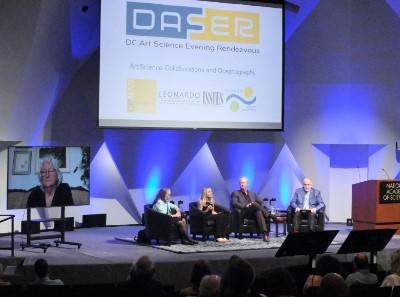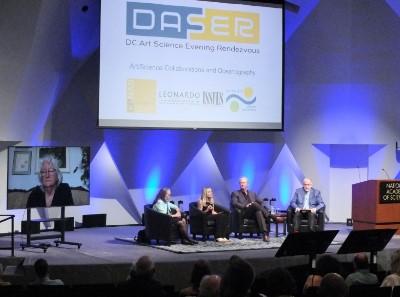The National Academy of Sciences (NAS) hosted their monthly D.C. Art Science Evening Rendezvous (DASER) Sept. 7, featuring artists and scientists involved in the Ocean Memory Project, a nationwide, transdisciplinary research project about the ocean’s past, present and future.
The event highlighted the work of Rebecca Rutstein, a multidisciplinary artist and member of the Ocean Memory Project. Rutstein’s ocean-inspired exhibit Blue Dreams, currently on display at the NAS, combines computer generated images, layered sounds, footage of the deep sea and other art mediums in a video installation that immerses the viewer in the ocean’s intricate and fascinating environment.
Rutstein describes Blue Dreams as a transformative window into oceanic environments, which are often hidden from view. She intended for the immersive experience in Blue Dreams to inspire a sense of curiosity and stewardship towards the ocean and the microbial processes that support life on Earth.
“I hope it encourages people to begin to see the ocean in a different way; to have more empathy towards these vast microbial networks which we rely on for our own survival,” Rutstein said.
DASER, a free, monthly discussion held at the NAS, empowers the public to learn more about local interdisciplinary science projects, like Blue Dreams. Alana Quinn, the NAS’s senior program associate of cultural programming, said DASER allows people in the D.C. area to experience science through different mediums.
“Our organization sees the arts as a lens through which to reach and engage a much broader audience,” Quinn told The Hoya.
DASER attendees, who work at the intersection of art and science, had a chance to talk about their projects during the community share portion of the event. Quinn said through this communal aspect of DASER, local artists and scientists can foster interdisciplinary relationships.
“Community share offers a way for people in the community to connect with one another,” Quinn said. “We hope that it will spark creativity by fostering new connections, collaborations and possibly even new projects.”
The Ocean Memory Project, which headlined the DASER event, similarly values interdisciplinary collaboration. The group, which consists of individuals working in science, humanities and the arts, is interested in the concept of ocean memory, the ocean’s ability to store and recall information like biological or geological data across time.
Rutstein, whose artwork embodies the interdisciplinary approach of the Ocean Memory Project and DASER, said her work envisions the ocean as a living thing that can record environmental events, such as climate change.
“The way I interpret Ocean Memory is thinking of the ocean and its inhabitants as one living and interconnected system that has agency and memory,” Rutstein told The Hoya.

To create Blue Dreams, Rutstein worked closely with scientists involved in the Ocean Memory Project, such as oceanographer Mandy Joye. Joye, who spoke at DASER, assisted Rutstein’s project by providing video footage from her deep sea excursions. Tom Skalak, another speaker at DASER, works with the Ocean Memory Project as a bioengineer. Skalak helped Rutstrein translate oceanic data into a large-scale artistic representation. Jody Deming, a marine microbiologist and member of the NAS, also served as an advisor on Blue Dreams and spoke at DASER.
“I couldn’t have done it without the input and the knowledge that they shared,” Rutstein said. “It was a collaborative process.”
Quinn, who organized the collaboration between DASER, the Ocean Project and Rutstein, said collaborations between science and art are mutually beneficial endeavors.
“Artwork can inspire awe about a topic in a way that a scientific paper might not, and the sheer wonder of the world around us and of scientific discoveries can provide rich and meaningful inspiration for artists,” Quinn said.
Rutstein said she believes the intersection of art and science has an especially vital role in addressing the major environmental crises facing our world today.
“Scientists can write papers, share charts and graphs that urge you to ‘look at this,’ but a work of art can evoke emotion, resonate and connect with the public in a way that science can’t on its own.”









